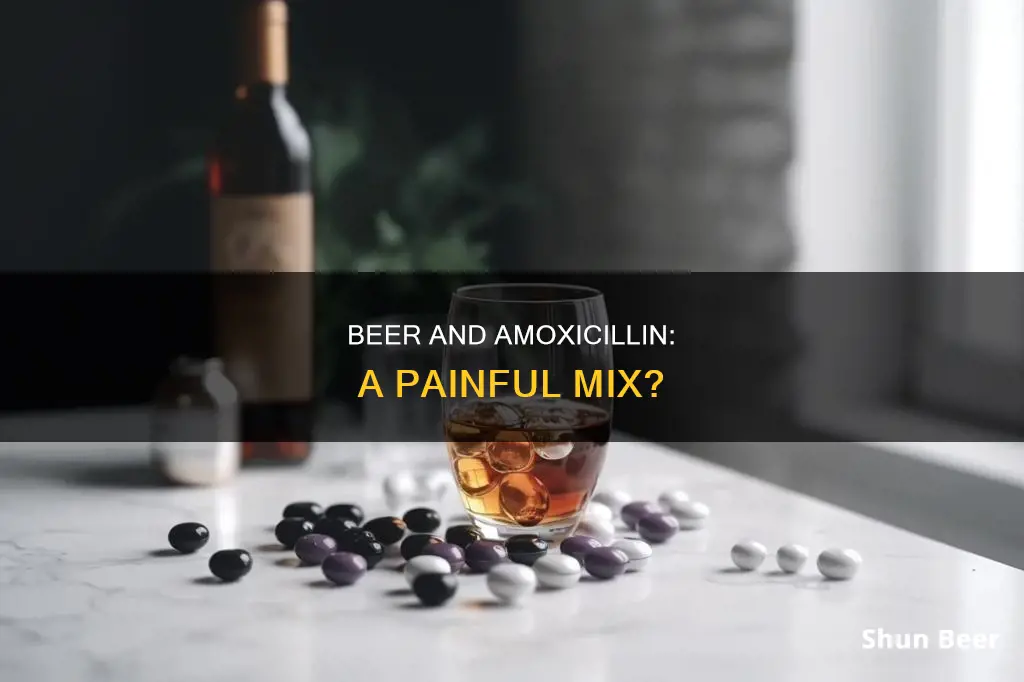
Drinking alcohol while taking antibiotics is generally not recommended. Alcohol can increase the risk of side effects, such as nausea, abdominal discomfort, and dehydration, and may also slow down the body's recovery from sickness or infection. While there are no known severe side effects of drinking beer with amoxicillin, a broad-spectrum antibiotic, it is still advised to avoid alcohol to give your body the best chance to fight the infection.
| Characteristics | Values |
|---|---|
| Is it safe to drink beer while taking amoxicillin? | It is less dangerous to drink alcohol while taking amoxicillin than it is to drink with many other drugs, but it is still highly recommended that potential drinkers abstain. |
| What are the risks of drinking alcohol while taking amoxicillin? | Alcohol may slow down the absorption of amoxicillin, making it less effective. Alcohol can also worsen existing side effects of amoxicillin, such as nausea, or cause additional side effects. Alcohol weakens the immune system, which may reduce amoxicillin's effectiveness and increase the time it takes to recover. |
| Are there any specific side effects to drinking beer while taking amoxicillin? | No specific side effects are mentioned, but alcohol may worsen common amoxicillin side effects such as nausea and abdominal discomfort. |
| How long should I wait after taking amoxicillin to drink beer? | It is recommended to wait between 48 and 72 hours after completing the course of amoxicillin before consuming alcohol. |
What You'll Learn
- Amoxicillin is an antibiotic used to treat bacterial infections in both adults and children
- Alcohol can be consumed with amoxicillin, but it is not recommended by health professionals
- Drinking alcohol while taking amoxicillin can slow the rate of the medicine's absorption and worsen side effects
- Common side effects of amoxicillin include nausea, abdominal discomfort, and diarrhoea
- It is best to wait 48 to 72 hours after finishing a course of amoxicillin before consuming alcohol

Amoxicillin is an antibiotic used to treat bacterial infections in both adults and children
Amoxicillin is a penicillin-like antibiotic used to treat bacterial infections in both adults and children. It is available on prescription and comes in capsules, tablets, chewable tablets, and liquid suspension forms. It is typically taken every 8 or 12 hours, depending on the type and severity of the infection. Amoxicillin is often prescribed to children to treat ear and chest infections. It is also used to treat infections in other parts of the body, such as the lungs, nose, sinus, skin, and urinary tract. In addition, it can be used in combination with other medications to treat stomach ulcers caused by the Helicobacter pylori (H. pylori) bacterium.
Amoxicillin works by killing and preventing the growth of bacteria. It is important to note that this medication will not work for viral infections such as colds or the flu. The most common side effects of amoxicillin include feeling sick (nausea) and diarrhoea. Other possible side effects include tooth discolouration, skin rashes, and allergic reactions. It is important to continue taking amoxicillin until the prescribed course is completed, even if symptoms improve.
While it is generally safe to drink alcohol while taking amoxicillin, combining antibiotics and alcohol can increase the risk of developing side effects. Alcohol can interfere with the body's ability to heal from an infection by disrupting sleep patterns and inhibiting the absorption of vital nutrients. Therefore, it is recommended to wait until the antibiotic course is completed before consuming alcohol.
Beer and Fasting: What You Need to Know
You may want to see also

Alcohol can be consumed with amoxicillin, but it is not recommended by health professionals
Although it is possible to consume alcohol with amoxicillin, it is not recommended by health professionals. Amoxicillin is a commonly prescribed antibiotic used to treat bacterial infections in both adults and children. It is effective against a wide range of bacterial infections, including dental and respiratory infections, and urinary tract infections.
When considering drinking alcohol while taking amoxicillin, it is important to understand the potential risks and side effects. Firstly, alcohol can slow down the absorption rate of amoxicillin, meaning it may take longer for the medication to start working. Alcohol can also increase the common side effects of amoxicillin, such as nausea and abdominal discomfort. Additionally, alcohol weakens the immune system, which may reduce the effectiveness of amoxicillin in fighting infections. It can also slow down the healing and recovery process, prolonging your illness.
Furthermore, drinking alcohol while taking any medication can be risky as it may interfere with drug therapy. Alcohol can speed up or slow down how your body processes medication, affecting its effectiveness and increasing the risk of side effects or toxicity. It is always best to consult with a healthcare professional before mixing alcohol with prescription drugs to understand the potential health risks.
While there may be no severe side effects when consuming alcohol with amoxicillin, it is still advisable to avoid or minimise alcohol consumption whenever you are sick or taking antibiotics. To be safe, it is recommended to wait between 48 to 72 hours after completing your course of amoxicillin before drinking alcohol. This will ensure that your body has the best chance to fight the infection and recover fully.
Beer Towers: How Do They Work?
You may want to see also

Drinking alcohol while taking amoxicillin can slow the rate of the medicine's absorption and worsen side effects
While amoxicillin is considered relatively safe to consume with alcohol, studies have shown that drinking alcohol while taking this medication can slow down the rate at which the body absorbs the antibiotic. This means that amoxicillin may take longer than usual to start working if consumed with alcohol. Additionally, alcohol can increase the risk of experiencing side effects associated with amoxicillin.
For example, one of the side effects of amoxicillin is nausea, and consuming alcohol while taking this medication can worsen these feelings. Alcohol use can also increase the risk of other side effects, such as abdominal discomfort and diarrhoea. Furthermore, alcohol weakens the immune system, which may reduce the effectiveness of amoxicillin in treating infections.
It is important to note that while amoxicillin and alcohol may not have severe interactions, drinking alcohol while taking any medication can interfere with drug therapy and prolong recovery time. Therefore, it is generally recommended to limit or avoid alcohol consumption while taking medications, including amoxicillin. To avoid potential health risks, it is always best to consult with a healthcare provider before consuming alcohol with any prescription medication.
Kegerator and Stella: A Perfect Match?
You may want to see also

Common side effects of amoxicillin include nausea, abdominal discomfort, and diarrhoea
Amoxicillin is a medication used to treat bacterial infections, such as pneumonia, bronchitis, skin infections, and urinary tract infections. It is a penicillin-like antibiotic that works by stopping the growth of bacteria. While it is a common and effective treatment, there are some side effects associated with its use.
One of the most common side effects of amoxicillin is nausea. Nausea is the feeling of discomfort and sickness in the stomach, often accompanied by the urge to vomit. It can range from mild to severe and may be accompanied by other symptoms such as vomiting, diarrhoea, and abdominal pain.
Abdominal discomfort is another possible side effect of amoxicillin. This can manifest as pain, cramps, or tenderness in the stomach area. In some cases, it may be indicative of a more serious condition, such as drug-induced enterocolitis syndrome (DIES), which requires immediate medical attention.
Diarrhoea is also a common side effect of amoxicillin. It can range from mild to severe and may be accompanied by stomach cramps and blood or mucus in the stool. Diarrhoea can be a sign of a more serious condition, such as a severe intestinal infection caused by the bacteria C. difficile. It is important to seek medical advice if diarrhoea persists or is accompanied by other concerning symptoms.
While amoxicillin is generally well-tolerated, these common side effects can cause discomfort and impact an individual's quality of life. It is important to weigh the benefits of the medication against the potential side effects and to seek medical advice if any concerning symptoms occur.
Beer and Pre-Diabetes: What's the Verdict?
You may want to see also

It is best to wait 48 to 72 hours after finishing a course of amoxicillin before consuming alcohol
Amoxicillin is a commonly prescribed antibiotic used to treat bacterial infections in both adults and children. It is considered relatively safe to drink alcohol while taking amoxicillin as it will not stop the medication from working. However, it is generally recommended to avoid alcohol while taking any medication, including amoxicillin, to give your body the best chance to fight the infection.
Drinking alcohol while taking amoxicillin can have several negative effects. Firstly, alcohol can slow down the absorption rate of amoxicillin, delaying its effectiveness in treating the infection. Alcohol can also increase the common side effects of amoxicillin, such as nausea and abdominal discomfort. Additionally, alcohol weakens the immune system, which may reduce the effectiveness of amoxicillin and prolong the recovery time.
Therefore, it is best to wait for a period of time after finishing a course of amoxicillin before consuming alcohol. Specifically, it is recommended to wait between 48 to 72 hours after completing the amoxicillin course before drinking any alcohol. This allows the body sufficient time to recover from the infection and reduces the risk of experiencing negative side effects.
It is important to note that while there are no severe side effects reported specifically from drinking alcohol while on amoxicillin, combining alcohol with certain other antibiotics can result in serious reactions and side effects. It is always advisable to consult with a healthcare professional or pharmacist for specific recommendations and to confirm the potential health risks of mixing alcohol with any prescription medication.
Beer and Brain Cells: Fact or Fiction?
You may want to see also
Frequently asked questions
Drinking alcohol while taking amoxicillin is less dangerous than drinking with many other drugs. However, health professionals recommend avoiding alcohol to give your body the best chance to fight the infection.
It is recommended to wait between 48 and 72 hours after completing your course of amoxicillin before drinking alcohol.
Common side effects of mixing alcohol and amoxicillin include nausea, abdominal discomfort, and dehydration.
No, there are certain antibiotics that should not be mixed with alcohol, including metronidazole, tinidazole, and Bactrim.
Drinking alcohol while taking amoxicillin can weaken your immune system, making it harder for your body to fight infections. It can also slow down the absorption rate of the medication, delaying its effectiveness.







